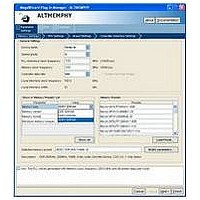IPR-HPMCII Altera, IPR-HPMCII Datasheet - Page 31

IPR-HPMCII
Manufacturer Part Number
IPR-HPMCII
Description
IP CORE Renewal Of IP-HPMCII
Manufacturer
Altera
Datasheet
1.IP-HPMCII.pdf
(176 pages)
Specifications of IPR-HPMCII
Software Application
IP CORE, Memory Controllers, SDRAM
Supported Families
Arria II GX, HardCopy III, Stratix III, Stratix IV
Core Architecture
FPGA
Core Sub-architecture
Arria, HardCopy, Stratix
Rohs Compliant
NA
Lead Free Status / RoHS Status
na
- Current page: 31 of 176
- Download datasheet (4Mb)
Chapter 3: Parameter Settings
ALTMEMPHY Parameter Settings
Table 3–2. Memory Presets List
December 2010 Altera Corporation
Memory type
Memory vendor
Memory format
Maximum frequency
Parameter Name
1
1
Table 3–2
displayed. This set of options is where you indicate whether you are creating a
datapath for DDR3 SDRAM.
Using the Preset Editor to Create a Custom Memory Preset
Pick a device in the Memory Presets list that is closest or the same as the actual
memory device that you are using. Then, click the Modify Parameters button to
parameterize the following settings in the Preset Editor dialog box:
■
■
■
Even though the device you are using is listed in Memory Presets, ensure that the
settings in the Preset Editor dialog box are accurate, as some parameters may have
been updated in the memory device datasheets.
You can change the parameters with a white background to reflect your system. You
can also change the parameters with a gray background so the device parameters
match the device you are using. These parameters in gray background are
characteristics of the chosen memory device and changing them creates a new custom
memory preset. If you click Save As (at the bottom left of the page) and save the new
settings in the <quartus_install_dir>\quartus\common\ip\altera\altmemphy\lib\
directory, you can use this new memory preset in other Quartus II projects created in
the same version of the software.
When you click Save, the new memory preset appears at the bottom of the Memory
Presets list in the Memory Settings tab.
If you save the new settings in a directory other than the default directory, click Load
Preset in the Memory Settings tab to load the settings into the Memory Presets list.
You can filter the type of memory to display, for example, DDR3 SDRAM.
You can filter the memory types by vendor. JEDEC is also one of the options, allowing you to
choose the JEDEC specifications. If your chosen vendor is not listed, you can choose JEDEC for the
DDR3 SDRAM interfaces. Then, pick a device that has similar specifications to your chosen device
and check the values of each parameter. Make sure you change the each parameter value to match
your device specifications.
You can filter the type of memory by format, for example, discrete devices or DIMM packages.
You can filter the type of memory by the maximum operating frequency.
Memory attributes—These are the settings that determine your system's number
of DQ, DQ strobe (DQS), address, and memory clock pins.
Memory initialization options—These settings are stored in the memory mode
registers as part of the initialization process.
Memory timing parameters—These are the parameters that create and
time-constrain the PHY.
describes the options available to filter the Memory Presets that are
Section II. DDR3 SDRAM Controller with ALTMEMPHY IP User Guide
Description
External Memory Interface Handbook Volume 3
3–3
Related parts for IPR-HPMCII
Image
Part Number
Description
Manufacturer
Datasheet
Request
R

Part Number:
Description:
IP NIOS II MEGACORE RENEW
Manufacturer:
Altera
Datasheet:

Part Number:
Description:
IP CORE Renewal Of IP-XAUIPCS
Manufacturer:
Altera
Datasheet:

Part Number:
Description:
IP CORE Renewal Of IP-10GETHERNET
Manufacturer:
Altera
Datasheet:

Part Number:
Description:
IP CORE Renewal Of IP-ASI
Manufacturer:
Altera
Datasheet:

Part Number:
Description:
IP CORE Renewal Of IP-CIC
Manufacturer:
Altera
Datasheet:

Part Number:
Description:
IP CORE Renewal Of IP-CRC
Manufacturer:
Altera
Datasheet:

Part Number:
Description:
IP CORE Renewal Of IP-ED8B10B
Manufacturer:
Altera
Datasheet:

Part Number:
Description:
CPLD, EP610 Family, ECMOS Process, 300 Gates, 16 Macro Cells, 16 Reg., 16 User I/Os, 5V Supply, 35 Speed Grade, 24DIP
Manufacturer:
Altera Corporation
Datasheet:

Part Number:
Description:
CPLD, EP610 Family, ECMOS Process, 300 Gates, 16 Macro Cells, 16 Reg., 16 User I/Os, 5V Supply, 15 Speed Grade, 24DIP
Manufacturer:
Altera Corporation
Datasheet:

Part Number:
Description:
Manufacturer:
Altera Corporation
Datasheet:










